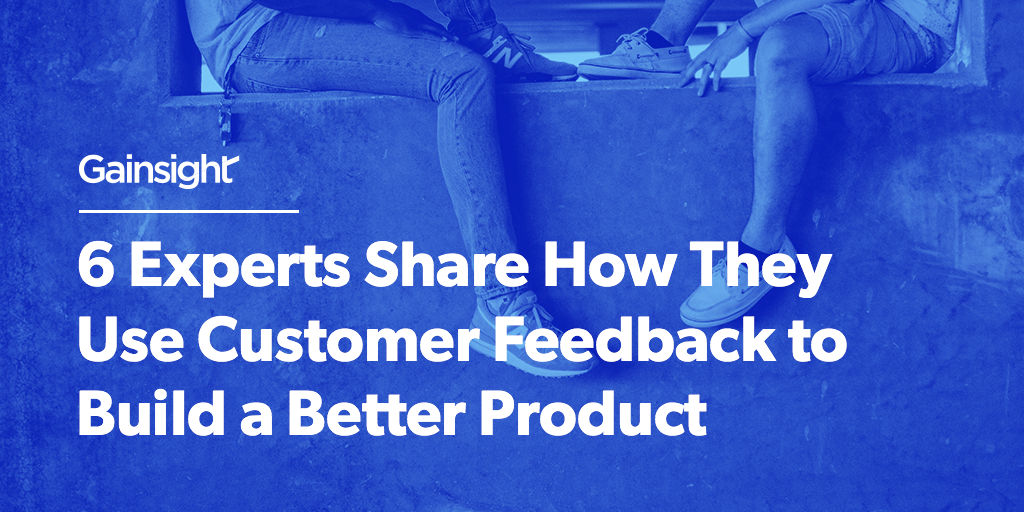There is no shortage of feedback these days. But what is everyone doing with it?
When you’re trying to deliver an exceptional product, it’s easy to get lost in the constant deluge of customer feedback. Your users are likely communicating with your company through multiple channels and it can seem like feedback gets lost in a black hole. So we asked six experts the following questions to learn more about how they collect and prioritize customer feedback:
- What are some of the effective ways you collect feedback?
- How do you work with your customer-facing teams to gather feedback?
- How do you prioritize what feedback gets incorporated into the product roadmap?
Read on to learn how these six product professionals listen and act on customer feedback. You’ll see that while each company’s process is unique, there are some common threads that tie them together.
6 Customer Feedback Processes from Product Management Experts
Chris Chumley
Chief Operating Officer | CampusLogic
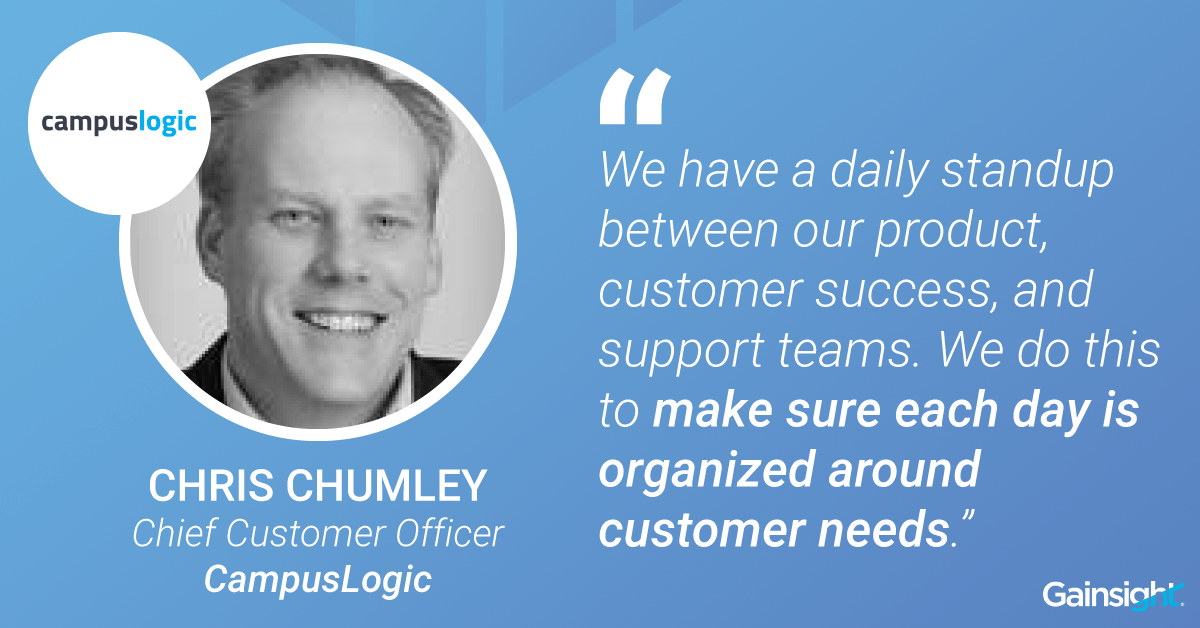
Q: What are some of the effective ways you collect feedback?
A: We use several channels to collect feedback. All of our customers have the ability to submit feedback directly through a widget in our product. During onboarding, we teach customers how to use our support portal to submit feature requests or bugs. These get routed directly to the product team. We’re on a continuous delivery model, so our product team triages this feedback weekly.
From a bigger, strategic roadmap perspective, we get that from our executive business reviews or our insider program. It’s not an official product advisory group—we pull in different types of customers depending on the topic. We sell to schools, so depending on the product idea that we have or the decisions we’re trying to make, we need to talk to different kinds of users.
Q: How do you work with your customer-facing teams to gather feedback?
A: We have a daily standup between our product, customer success, and support teams. We do this to make sure each day is organized around customer needs. Twice a month our onboarding and product teams deep dive into feedback. They surface challenges and try to create a solution for the customer. We hold monthly meetings with our sales and pre-sales teams to learn more about the questions they’re getting asked during demos or suggestions from prospects.
What’s unique about CampusLogic is that our customer success, product, and engineering teams all report to me (COO). The CSM represents the customer in all of our planning and this structure in general allows for us to be more aligned.
We also leverage a Slack channel so our teams can get immediate internal support. For example, if an onboarding teammate runs into a customer question they can’t answer, a product expert can provide answers in real time. We’re very focused on TTV, so we’re always looking for ways to make the process smoother.
Q: How do you prioritize what feedback gets incorporated into the product roadmap?
A: We’re on a continuous delivery model—we release code every 1.6 business days—so this process of prioritization is really important to us. It’s sometimes a lot more art than science, to be honest. A few areas of focus for us include the following:
- Because we’re in a regulated industry, anything that might impact our product for regulatory reasons gets prioritized.
- We look for enhancement trends. Every week we review data to identify patterns. Are multiple customers trying to solve the problem or getting stuck in the same place?
I think it’s also important to note that when it comes to customer feedback, you need to be judicious—you can’t just do everything that everyone asks. You must have a strong identity for your product. You need to know what it’s meant for and what it solves. Your customers might stray and find other ways to use your product but don’t let that take you off course from your original intended use. Ask yourself, “Is this something our product should be doing? Was this a promise we made to our customers?” If the answer is yes, then it’s something we should look into.
It’s not the volume of feedback you implement that matters, it’s what eventually ends up into the product that moves it forward. A lot of the feedback you see at the beginning of onboarding could be happening because they’re not fully adopted yet. That’s where aligning customer success and product is super helpful because they can work together with the customer to address certain knee-jerk reactions that come with change management.
All in all, you should strive to be very thoughtful with the changes that you make for the long term maintenance of the product
Clement Kao
Product Manager | Blend
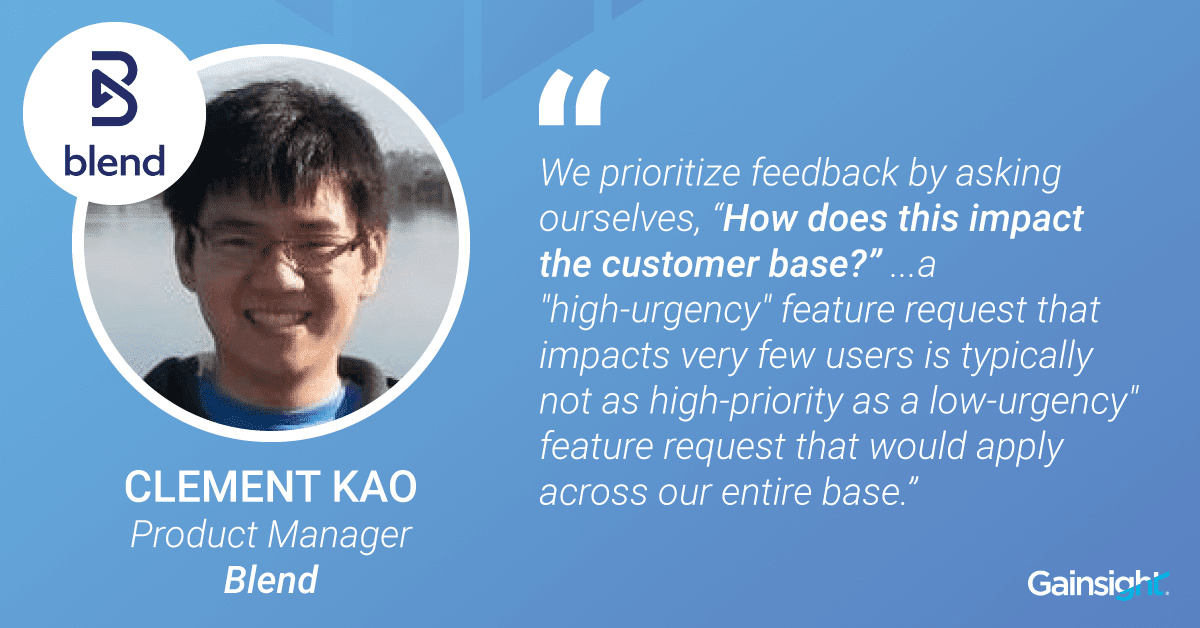
Q: What are some of the effective ways you collect feedback?
A: We collect feedback in a variety of ways. Customer support tickets help us better understand our user’s pain points on a day-to-day basis and account manager updates help us better understand the business priorities of our customers. Our customer executives and our executive team also hold conversations to align on the joint vision that we’re building together.
Q: How do you work with your customer-facing teams to gather feedback?
A: All of our customer-facing teams file their feedback into Salesforce. This includes the three methods above: customer support tickets, account manager updates, and executive conversations.
We tag each piece of feedback with the impacted account, the feature area, and its priority to the customer. Included is a detailed write-up of the customer story, so we have access to rich information.
- Product managers regularly dive into Salesforce to focus on their feature areas across accounts and use that to build the product roadmap.
- Account managers regularly dive into Salesforce to focus on their accounts and look for themes that they can more proactively address.
- Support regularly dives into Salesforce to look for repeated workflow complaints, which we can then fix through Help Center articles, webinars, trainings, or product enhancements.
Q: How do you prioritize what feedback gets incorporated into the product roadmap?
A: We prioritize feedback by asking ourselves, “How does this impact the customer base?” As an example, a “high-urgency” feature request that impacts very few users is typically not as high-priority as a “low-urgency” feature request that would apply across our entire base.
Of course, when the feedback comes in, it doesn’t come in with a calculation of “how many users are impacted,” so that’s up to the product manager to determine through analytics, customer interviews, and shadowing. Once we get a grasp of breadth and urgency, we then have a clear sense of the benefit that we would unlock across the customer base.
Product managers focus on the highest ROI items first—and ROI is benefits divided by costs. So, product managers then work with engineers and designers to determine what the potential solution might be and what the cost of the solution is. From there, we can then determine the ROI of any given initiative and use that to determine where it best fits in the roadmap.
Connie Kwan
VP of Product as a Service | Product Maestro
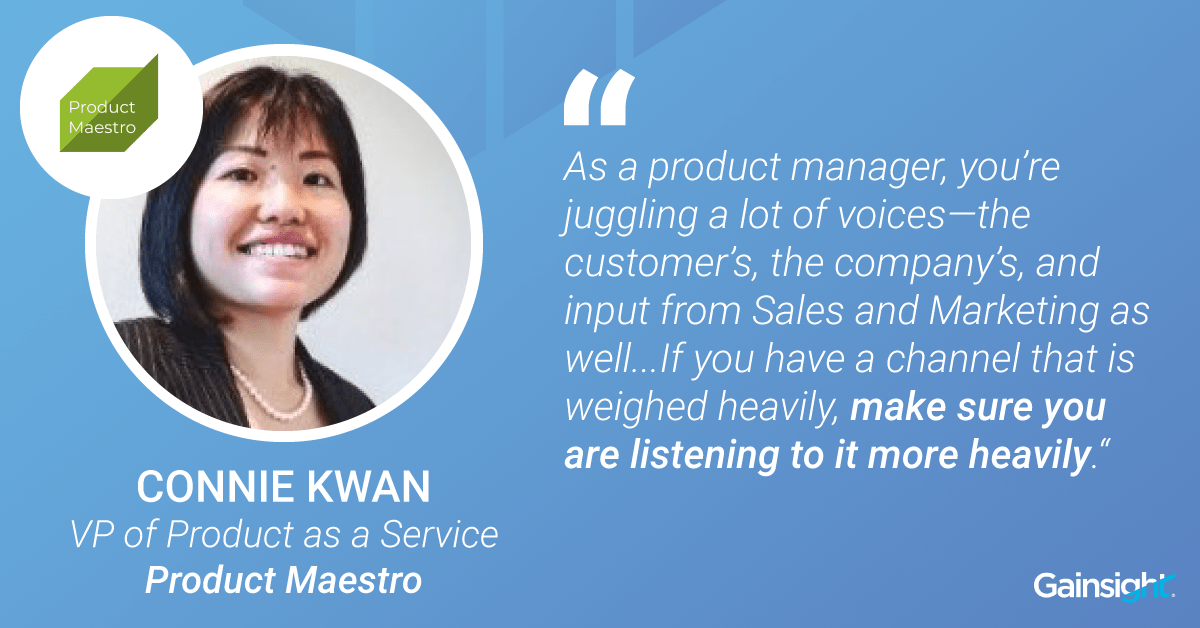
Q: What are some of the effective ways you collect feedback?
A: One of the most effective ways to collect feedback is through a customer council. This is a returning group of customers who review upcoming mockups and give constructive feedback. By using the same customers, they become more familiar with the products which can lead to deeper feedback. This method provides a wide variety of perspectives and to optimize this, we rotate membership in the council.
Q: How do you work with your customer-facing teams to gather feedback?
A: We use a project collaboration tool to store the feedback that’s shared with our customer-facing teams. Those teams tag us when they come across feedback that’s worth our notice. We also get consolidated reports that we can then browse through and use in support of specific feature priorities.
Q: How do you prioritize what feedback gets incorporated into the product roadmap?
A: I like to set aside a target ratio of feedback sources, this way we make sure we incorporate the right feedback in the right ratio.
The target ratio is a judgment call and gets easier with experience. As a product manager, you’re juggling a lot of voices—the customer’s, the company’s, and input from Sales and Marketing as well. The input from these channels is both qualitative and quantitative and how you balance the two is dependant upon your product. If you have a channel that is weighed heavily, make sure you are listening to it more heavily.
In a way, your target ratio is an audit of how well you do your customer feedback collection process.
Josh Lowy
Co-founder & CEO | Hugo
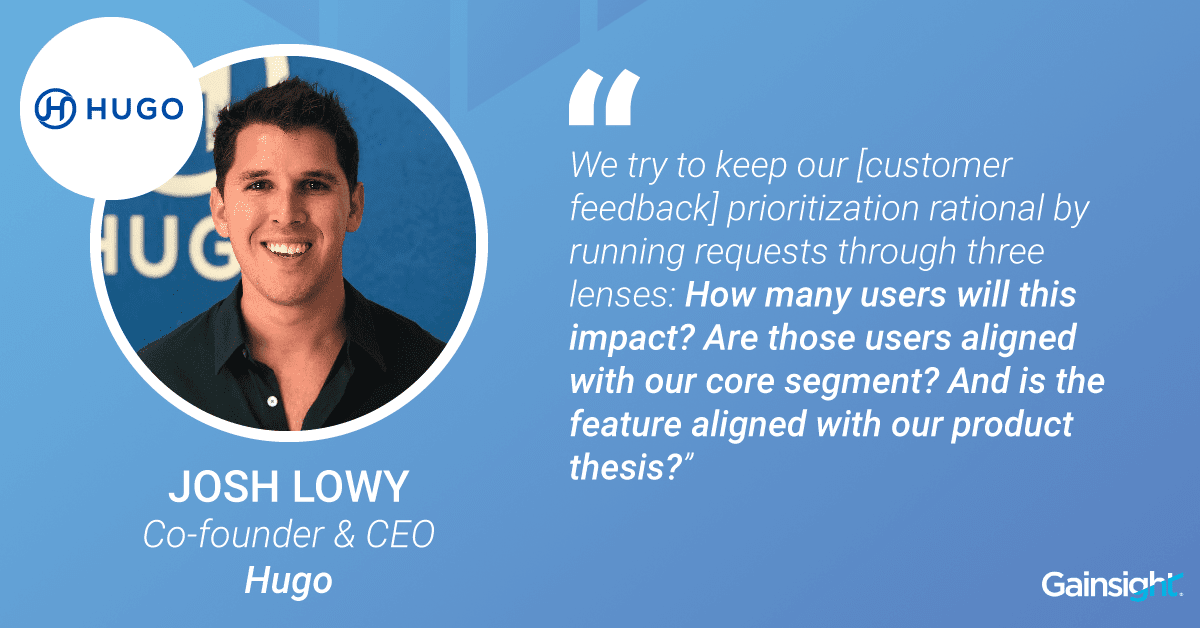
Q: What are some of the effective ways you collect feedback?
A: To be effective, you need to have good coverage across the full spectrum of feedback types. We measure everything that comes through existing channels (live chat, email, product demo calls, etc.) and send feedback through to our product roadmap. We link each piece of feedback back to the customer, making it easy to prioritize feedback at scale.
Another approach we take is the heavy use of feature flags. This allows us to run experiments safely. Most new features are only released to a small group of customers in our beta program. This creates a critical dialogue that helps us validate the new work and find last-minute gaps that need to be plugged before a public roll-out. It also rewards our most engaged customers because they love having early access, which in turn increases the quality of feedback.
Finally, we run outreach programs every few months. This helps us identify user groups that exhibit behaviors we would like to improve. We then schedule interviews to get a better understanding of the job-to-be-done that the customers actually want.
Q: How do you work with your customer-facing teams to gather feedback?
A: We have two critical principles for the interface between customer-facing teams and the rest of the company.
The first is real-time sharing so everyone is able to keep a general pulse on customer sentiment, new opportunities to focus on, or how recent features are performing.
The second is to make sure that everything heard by those customer-facing teams is captured and indexed (using categories like customer ids, product category, account size, etc.). This means anything being picked up through real-time sharing (i.e. customers complaining about feature X), can be looked at in aggregate.
This process makes it easy to validate if a complaint is indeed a priority or just another case of recency bias. This also makes it easy to get back to customers with more questions or to notify them that their feature request is live because they are linked to those insights from the beginning.
Q: How do you prioritize what feedback gets incorporated into the product roadmap?
A: It’s certainly a tough balancing act that we don’t always get right. We try to keep our prioritization rational by running requests through three lenses:
- How many users will this impact?
- Are those users aligned with our core segment?
- Is the feature aligned with our product thesis or could it result in divergence?
Having trouble surfacing the feedback that will make the biggest impact?
Watch a quick, 3-minute demo of Gainsight PX for an introduction to the easy, powerful, and complete product experience platform.
Tyson Brown
Product Manager | Keap
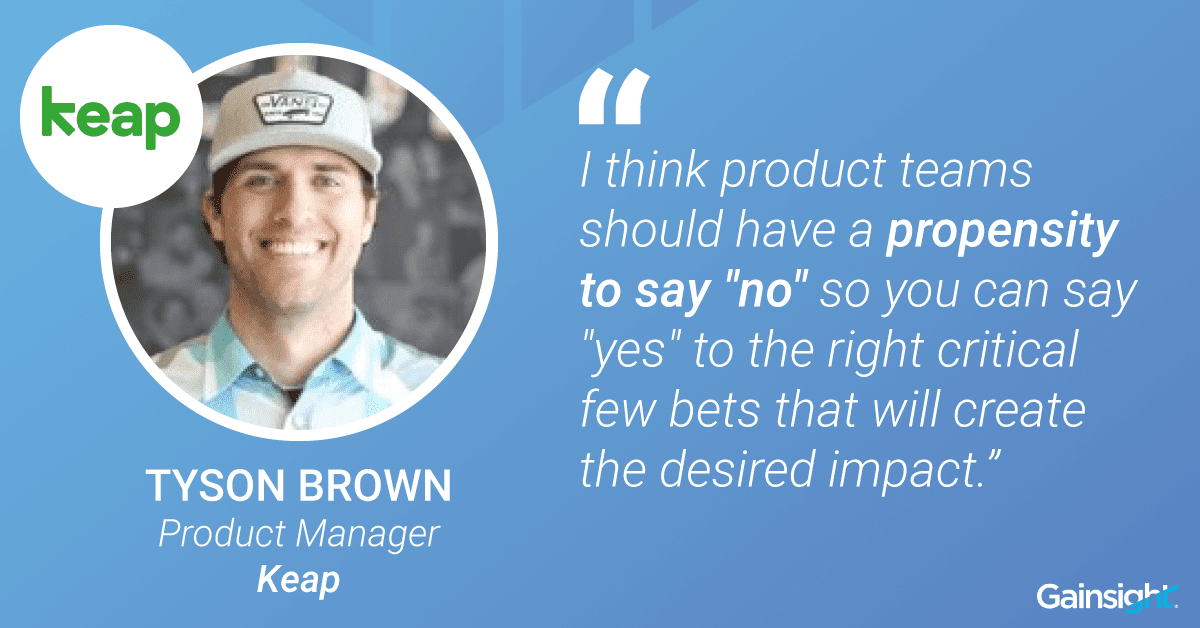
Q: What are some of the effective ways you collect feedback?
A: There are three main ways that we collect feedback. We talk to our users—usually offering a gift card in exchange for an interview. This is an effective way to gather qualitative insights. We leverage SaaS tools to gather user behavioral data (click tracking, etc.). We also utilize surveys but feel they’re best used to reinforce the strategic direction of our product not to inform our backlog of features. We make it a priority to talk to users first to learn more about their specific concerns so we can create tests to solve the problem.
Q: How do you work with your customer-facing teams to gather feedback?
A: When our support team receives feedback from customers, they log it into our support platform. When a certain theme arises, we meet with reps to define and document specific problems and use cases. We also pull our customer-facing reps into the prototype design process to get their perspective and validation on whether the proposed solution would solve the users’ problems.
Q: How do you prioritize what feedback gets incorporated into the product roadmap?
A: We ask ourselves the following questions: “What improvements give confidence to increase acquisition, reduce churn, generate additional revenue per existing customers?” and, “What’s the level of effort vs. impact” Enhancements that take low effort but will have a high impact are prioritized. Most importantly, I think product teams should have a propensity to say “no” so you can say “yes” to the right critical few bets that will create the desired impact.
Kailee Urban
Product Alignment Lead | FullStory
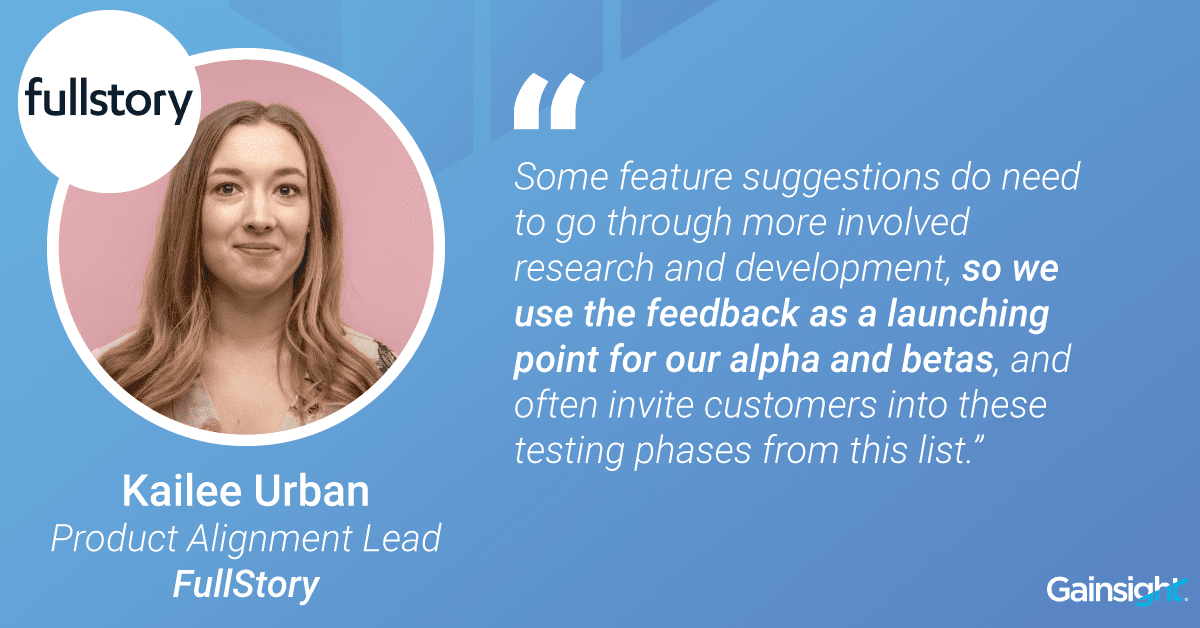
Q: What are some of the effective ways you collect feedback?
A: The main way we collect feedback is through our Product Feedback Custom Object that we created in Salesforce. We curate a list of the most common requests and map them to larger categories of work and product subfamilies.
Collecting feedback in Salesforce allows us to automatically populate information about the account or opportunity into the request—such as company type, ARR or opportunity size, business segment, use case function, etc.—so we have a better understanding of who is asking for what. We can then aggregate these requests in order to prioritize what our customers want when planning our OKR cycles.
From within the FullStory UI, we also have a Searchie Suggestion form at the bottom of our Searchies (our name for data visualizations) where our customers can submit ideas for future Searchies. These suggestions are sent directly into a Slack channel for immediate visibility.
We also collect internal feedback / ideas through a bot we created in Slack, Subconscious, that feeds into a Clubhouse workflow. This is a place for our own “Wouldn’t it be cool if?” thoughts that we don’t want to forget.
Q: How do you work with your customer-facing teams to gather feedback?
A: The main reason for collecting customer and prospect feedback through our Salesforce Product Feedback Custom Object was to meet our teams where they are. This allows Sales and Customer Success Managers to quickly submit feedback on an account or opportunity when they are on a call or at an on-site. The Salesforce <> Zendesk integration makes it easy for Support to jump to an account in Salesforce from a Zendesk ticket when a customer has a request.
When we first launched this process, we trained all customer-facing teams on the how and why. It was just as important to make sure everyone understood the reason why were were gathering feedback as it was to show everyone how to submit it. Everyone is aligned on how critical it is for us to prioritize the right things for our customers. We also documented the process step-by-step with screenshots and hold meetings whenever a change is made to the feedback object or process to ensure everyone is in the know.
Q: How do you prioritize what feedback gets incorporated into the product roadmap?
A: Between each OKR cycle, we spend a week planning what to work on next (aka planning week). During this time, each Product family reviews the feedback that was submitted and identifies trends that can be folded into arcs of work (we developed a successful process for mapping out our product efforts called the 9-blocker).
This could mean individual features that are regularly being requested by our customers, or several features that make sense to work on together. We of course balance this with tech-debt, ongoing work on new features, and business decisions. Some feature suggestions do need to go through more involved research and development, so we use the feedback as a launching point for our alpha and betas, and often invite customers into these testing phases from this list.
If You Take Away Anything, Make It This
Takeaway #1: Collecting well-rounded feedback requires the use of multiple channels. Almost all of the interviewees in this article talk to customers in person to gather detailed sentiment. This is done through interviews, user groups, or advisory councils. Another main form of feedback collection is through tools that allow users to submit feedback directly in the product.
Takeaway #2: It takes a joint effort to make sure the voice of the customer is truly heard. The interviewees in this article all work with their customer-facing teams to gather feedback. Most work with their prospect-facing teams as well to know what could help drive deals.
Takeaway #3: There is no one-size-fits-all prioritization process for customer feedback. However, no prioritization process is complete without a deep understanding of your users and your product. What is important to customers? What is important to the business? Sometimes finding this balance is more art than science.
Feedback Straight From Gainsight Customers
We’re passionate about developing and sharing innovative ways that product and customer success teams can work together. These are just some of our customers who not only are using Gainsight to drive their goals, but are giving us great feedback in the process so we can all create better products.
- Bizzabo is using Gainsight to eliminate the need to manually find customer data and create rich, engaging product experiences. Read their case study here.
- Absorb Software evolved their entire user interface using customer feedback and analytics gathered through Gainsight PX. Read their case study here.
Customer Feedback All in One Place, With More Depth Than Ever Before
With Gainsight PX, the product experience platform, users can submit feedback directly through your product. You’ll gain a holistic view of customer feedback and with our product analytics, you’ll be able to make better product decisions. Gainsight PX integrates seamlessly with Gainsight CS too, so you can add even more depth and color to customer feedback.
Whether it’s said during a call to a customer success manager or in a survey through your product, gather it in one place and turn constructive feedback into reality with Gainsight PX.
Keep all of your customer feedback in one place with Gainsight. Whether it’s said during a call with a CSM or expressed through an in-app survey, Gainsight CS and Gainsight PX will help you collect and distill the feedback that matters most. Sign up for a personalized demo today!
